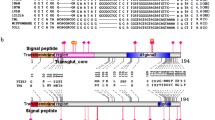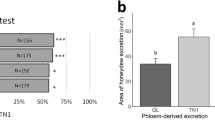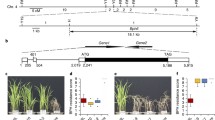Abstract
Plant defensins are small (5-10 kDa) basic peptides thought to be an important component of the defense pathway against fungal and/or bacterial pathogens. To understand the role of plant defensins in protecting plants against the brown planthopper, a type of insect herbivore, we isolated the Brassica rapa Defensin 1 (BrD1) gene and introduced it into rice (Oryza sativa L.) to produce stable transgenic plants. The BrD1 protein is homologous to other plant defensins and contains both an N-terminal endoplasmic reticulum signal sequence and a defensin domain, which are highly conserved in all plant defensins. Based on a phylogenetic analysis of the defensin domain of various plant defensins, we established that BrD1 belongs to a distinct subgroup of plant defensins. Relative to the wild type, transgenic rices expressing BrD1 exhibit strong resistance to brown planthopper nymphs and female adults. These results suggest that BrD1 exhibits insecticidal activity, and might be useful for developing cereal crop plants resistant to sap-sucking insects, such as the brown planthopper.
Similar content being viewed by others
References
Alfonso-Rubí, J., Ortego, F., Castañera, P., Carbonero, P., and Díaz, I. (2003). Transgenic expression of trypsin inhibitor CMe from barley in indica and japonica rice, confers resistance to the rice weevil Sitophilus oryzae. Transgenic Res. 12, 23–31.
Bandyopadhyay, S., Roy, A., and Das, S. (2001). Binding of garlic (Allium sativum) leaf lectin to the gut receptors of homopteran pests is correlated to its insecticidal activity. Plant Sci. 161, 1025–1033.
Cha, Y.S., Ji, H., Yun, D.W., Ahn, B.O., Lee, M.C., Suh, S.C., Lee, C.S., Ahn, E.K., Jeon, Y.H., Jin, I.D., et al. (2008). Fine mapping of the rice Bph1 gene, which confers resistance to the brown planthopper (Nilaparvata lugens Stal), and development of STS markers for marker-assisted selection. Mol. Cells 26, 146–151.
Clarke, J.D. (2009). Cetyltrimethyl ammonium bromide (CTAB) DNA miniprep for plant DNA isolation. Cold Spring Harb. Protoc: doi:10.1101/pdb.prot5177.
Dutta, I., Saha, P., Majumder, P., Sarkar, A., Chakraborti, D., Banerjee, S., and Das, S. (2005)a. The efficacy of a novel insecticidal protein, Allium sativum leaf lectin (ASAL), against homopteran insects monitored in transgenic tobacco. Plant Biotechnol. J. 3, 601–611.
Dutta, I., Majumder, P., Saha, P., Ray, K., and Das, S. (2005)b. Constitutive and phloem specific expression of Allium sativum leaf agglutinin (ASAL) to engineer aphid (Liphaphis erysimi) resistance in transgenic Indian mustard (Brassica juncea). Plant Sci. 169, 996–1007.
Epple, P., Apel, K., and Bohlmann, H. (1997). ESTs reveal a multigene family for plant defensins in Arabidopsis thaliana. FEBS Lett. 400, 168–172.
Falk, B., and Tsai, T.H. (1998). Biology and molecular biology of viruses in the genus tenuiviruses. Annu. Rev. Phytopathol. 36, 139–163.
Foissac, X., Thi Loc, N., Christou, P., Gatehouse, A.M., and Gatehouse, J.A. (2000). Resistance to green leafhopper (Nephotettix virescens) and brown planthopper (Nilaparvata lugens) in transgenic rice expressing snowdrop lectin (Galanthus nivalis agglutinin; GNA). J. Insect Physiol. 46, 573–583.
Gallagher, K.D., Kenmore, P.E., and Sogawa, K. (1994). Judicial use of insecticides deter planthopper outbreaks and extend the life of resistant varieties in Southeast Asia rice. In: R.F. Denno and J.T. Perfect, eds., Planthoppers: Their ecology and management, (Chapman & Hall, New York) pp. 599–614.
Jang, I.C., Choi, W.B., Lee, K.H., Song, S.I., Nahm, B.H., and Kim, J.K. (2002). High-level and ubiquitous expression of the rice cytochrome c gene (OsCc1) and its promoter activity in transgenic plants provides a useful promoter for transgenesis of monocots. Plant Physiol. 129, 1473–1481.
Kim, S.M., and Shon, J.K. (2005). Identification of a rice gene (Bph 1) conferring resistance to brown planthopper (Nilaparvata Iugens Stal) using STS markers. Mol. Cells 20, 30–34.
Lay, F.T., and Anderson, M.A. (2005). Defensins—components of the innate immune system in plants. Curr. Protein Pept. Sci. 6, 85–101.
Lee, S.I., Lee, S.H., Koo, J.C., Chun, H.J., Lim, C.O., Mun, J.H., Song, Y.H., and Cho, M.J. (1999). Soybean kunitz trypsin inhibitor (SKTI) confers resistance to the brown planthopper (Nilaparvata lugens Stal) in transgenic rice. Mol. Breed 5, 1–9.
Loc, N.T., Tinjuangjun, P., Gatehouse, A.M.R., Christou, P., and Gatehouse, J.A. (2002). Linear transgene constructs lacking vector backbone sequences generate transgenic rices which accumulate higher levels of proteins conferring insects resistance. Mol. Breed 9, 231–244.
Majumder, P., Banerjee, S., and Das, S. (2004). Identification of receptors responsible for binding of the mannose specific lectin to the gut epithelial membrane of the target insects. Glycoconj. J. 20, 525–530.
Mendez, E., Moreno, A., Colilla, F., Pelaez, F., Limas, G.G., Mendez, R., Soriano, F., Salinas, M., and de Haro, C. (1990). Primary structure and inhibition of protein synthesis in eukaryotic cell-free system of a novel thionin, gamma-hordothionin, from barley endosperm. Eur. J. Biochem. 194, 533–539.
Park, Y.S., Jeon, M.H., Lee, S.H., Moon, J.S., Cha, J.S., Kim, H.Y., and Cho, T.J. (2005). Activation of defense response in Chinese cabbage by a nonhost pathogene, Pseudomonas syringe pv. tomato. J. Biochem. Mol. Biol. 38, 748–754.
Powell, K.S. (2001). Antifeedant effects of plant lectins towards nymphal stages of the planthoppers Tarophagous proserphina and Nilaparvata lugens. Entomol. Exp. Appl. 99, 71–77.
Ramesh, S., Nagadhara, D., Reddy, V.D., and Rao, K.V. (2004). Production of transgenic indica rice resistant to yellow stem borer and sap-sucking insects, using super-binary vectors of Agrobacterium tumefaciens. Plant Sci. NSS, 1077–1085.
Roy-Barman, S., Sautter, C., and Chattoo, B.B. (2006). Expression of the lipid transfer protein Ace-AMP1 in transgenic wheat enhances antifungal activity and defense responses. Transgenic Res. 15, 435–446.
Saitoh, H., Kiba, A., Nishihara, M., Yamamura, S., Suzuki, K., and Terauchi, R. (2001). Production of antimicrobial defensin in Nicotiana benthamiana with a potato virus X vector. Mol. Plant-Microbe Interact. 14, 111–115.
Schuler, T.H., Poppy, G.M., Kerry, B.R., and Denholm, I. (1999). Insect-resistant transgenic plants. Trends Biotechnol. 16, 168–175.
Sohn, S.I., Kim, Y.H., Cho, J.H., Kim, J.G., and Lee, J.Y. (2006). An efficient selection scheme for Agrobacterium-mediated cotransformation of rice using two selectable marker genes hpt and bar. Korean J. Breed PU, 173–179.
Tan, G.X., Weng, Q.M., Ren, X., Huang, Z., Zhu, L.L., and He, G.C. (2004). Two whitebacked planthopper resistance genes in rice share the same loci with those for brown planthopper resistance. Heredity 92, 211–217.
Terras, F.R.G., Eggermont, K., Kovaleva, V., Raikhel, N.V., Osborn, R.W., Kester, A., Rees, S.B., Torrekens, S., Van Leuven, F., Vanderleyden, J., et al. (1995). Small cysteine-rich antifungal proteins from radish: their role in host defense. Plant Cell 7, 573–588.
Thevissen, K., François, I.E., Takemoto, J.Y., Ferket, K.K., Meert, E.M., and Cammue, B.P. (2003). DmAMP1, an antifungal plant defensin from dahlia (Dahlia merckii), interacts with sphingolipids from Saccharomyces cerevisiae. FEMS Microbiol. Lett. 226, 169–173.
Thevissen, K., Warnecke, D.C., François, I.E., Leipelt, M., Heinz, E., Ott, C., Zähringer, U., Thomma, B.P., Ferket, K.K., and Cammue, B.P. (2004). Defensins from insects and plants interact with fungal glucosylceramides. J. Biol. Chem. 279, 3900–3905.
Thomma, B.P., Cammue, B.P., and Thevissen, K. (2002). Plant defensins. Planta 16, 193–202.
Wisniewski, M.E., Bassett, C.L., Artlip, T.S., Robert, P.W., Janisiewicz, W.J., Norelli, J.I., Goldway, M., and Droby, S. (2003). Characterization of a defensin in bark and fruit tissues of peach and antimicrobial activity of a recombinant defensin in the yeast, Pichia pastoris. Physiol. Plant 119, 563–572.
Author information
Authors and Affiliations
Corresponding author
About this article
Cite this article
Choi, MS., Kim, YH., Park, HM. et al. Expression of BrD1, a plant defensin from Brassica rapa, confers resistance against brown planthopper (Nilaparvata lugens) in transgenic rices. Mol Cells 28, 131–137 (2009). https://doi.org/10.1007/s10059-009-0117-9
Received:
Revised:
Accepted:
Published:
Issue Date:
DOI: https://doi.org/10.1007/s10059-009-0117-9




